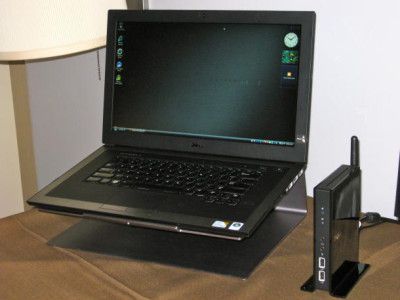From our front-page news:
When I purchased a notebook from Dell about five years ago, I was quite impressed with what I got. Today, I realize just how ridiculously expensive it was compared to notebooks of now (it felt mid-range, but cost $3,300), but I remember at the time wondering, "What can they possibly do to make notebooks even better?" Aside from the obvious, battery-life and performance, I wondered what features could be tacked on that would help keep things fresh.
Back then, "wireless power" didn't come to mind, although I would have been really excited to even just ponder the idea. But today, that's a reality - kind of - from Dell, with their Latitude Z business notebook. I say "kind of" because to me, it's not truly wireless power, and I'm not sure who could consider it as such. Wireless to me assumes some leeway about how far you could get from the source, and in the case here, we're talking millimeters, not meters.
Like many other notebooks, this one comes with a dock. What's different here, is that rather than the notebook slide into a connector or a cord need to be inserted, you simply have to set the notebook down and it will do it's thing. Technically, it is wireless, because there are no cables running from the notebook to the dock, but it has to be physically on the dock, so it's hard to tell the difference. This isn't exactly a cheap option, either. It's yours for $199, and as such, it's clearly targeted at business users (fair enough given it's a business class notebook).
Just how useful this feature is, is really up to you. One additional feature I really like, though, is Dell's version of an "instant-on" environment. Inside the notebook is a secondary (but much smaller) motherboard complete with an ARM processor. Users, when booting up, can boot into this non-Windows OS for basic tasks, such as e-mail, Web browsing and handling contacts and calendars. Why should you should care? Using this mode, you can get upwards of 2 days worth of battery-life, compared to 4 hours in a Windows environment. It's numbers like these that may finally give the "instant-on" OS the push it needs to hit mainstream popularity.
<table border="0" align="center"> <tbody> <tr> <td>

Credit: Erica Ogg</td> </tr> </tbody> </table>
What Dell, and DeviceVM, and Phoenix, and plenty of others are doing is part of a trend that's gaining steam: doing a sort of end-run around Windows. HP came out with its own interface on Touchsmart PCs last year that allows for quick sorting between photos, e-mail, and Web browsing on a few models. Lenovo recently introduced a new touch-screen interface for its tablet, and Asus has its own for its popular Eee PC Netbooks and touch-screen desktop called TouchGate.
Source: CNET
Back then, "wireless power" didn't come to mind, although I would have been really excited to even just ponder the idea. But today, that's a reality - kind of - from Dell, with their Latitude Z business notebook. I say "kind of" because to me, it's not truly wireless power, and I'm not sure who could consider it as such. Wireless to me assumes some leeway about how far you could get from the source, and in the case here, we're talking millimeters, not meters.
Like many other notebooks, this one comes with a dock. What's different here, is that rather than the notebook slide into a connector or a cord need to be inserted, you simply have to set the notebook down and it will do it's thing. Technically, it is wireless, because there are no cables running from the notebook to the dock, but it has to be physically on the dock, so it's hard to tell the difference. This isn't exactly a cheap option, either. It's yours for $199, and as such, it's clearly targeted at business users (fair enough given it's a business class notebook).
Just how useful this feature is, is really up to you. One additional feature I really like, though, is Dell's version of an "instant-on" environment. Inside the notebook is a secondary (but much smaller) motherboard complete with an ARM processor. Users, when booting up, can boot into this non-Windows OS for basic tasks, such as e-mail, Web browsing and handling contacts and calendars. Why should you should care? Using this mode, you can get upwards of 2 days worth of battery-life, compared to 4 hours in a Windows environment. It's numbers like these that may finally give the "instant-on" OS the push it needs to hit mainstream popularity.
<table border="0" align="center"> <tbody> <tr> <td>

Credit: Erica Ogg</td> </tr> </tbody> </table>
What Dell, and DeviceVM, and Phoenix, and plenty of others are doing is part of a trend that's gaining steam: doing a sort of end-run around Windows. HP came out with its own interface on Touchsmart PCs last year that allows for quick sorting between photos, e-mail, and Web browsing on a few models. Lenovo recently introduced a new touch-screen interface for its tablet, and Asus has its own for its popular Eee PC Netbooks and touch-screen desktop called TouchGate.
Source: CNET
